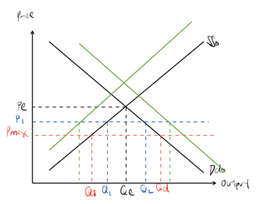(2020) A Level H2 Econs Essay Q2 Suggested Answer by Mr Eugene Toh (A Level Economics Tutor)
(2020) A Level H2 Econs Paper 2 Essay Q2
Disclaimer: The answers provided on our website is a 'first draft outline’ version of the answers provided for your convenience.
For the full, finalised answers, please click here to purchase a hard copy of the Comprehensive TYS Answers authored by Mr Eugene Toh and published by SAP. (The page might take awhile to load)
Search for “COMPREHENSIVE ANSWERS TO A LEVEL H2 ECONOMICS YEARLY EDITION” or “9789813428676” to purchase.
2. Concerns about future shortages of water resulted in Singapore’s national water agency, PUB, increasing the price of water by 30% from 2017. By 2060, Singapore’s total water demand could almost double.
(a) Explain why a shortage of water might still exist after the rise in the price of water. [10]
Why there was a shortage before
Water prices in Singapore are not determined via market forces of demand and supply.
Instead, water prices are determined by the government via the PUB (a government agency). As such, water prices have remained unchanged since 2000.
Increasing demand caused by the rising population as well as rising cost of production resulting in a fall in supply should have resulted increases in prices
Instead, an ‘unsaid’ price ceiling Pmax has been imposed on the price of water as seen in Figure 1 below.
As Pmax, the quantity demanded for water exceeds the quantity supplied of water.
The shortage is currently being met by PUB through the use of state funds
What happens after the rise in the price of water
A 30% increase in the price of water would unlikely bring the prices to the equilibrium price Pe, but instead bring the prices to P1
At P1, a shortage still exists as the quantity demanded at Q2 is still greater than the quantity supplied at Q1
Why a shortage might still exist after the rise in the price of water
As mentioned, the shortage might not have been completely eliminated if the 30% price increase does not sufficiently close the gap between Pmax and Pe
In addition, continued increases in population size will continue to increase demand while the higher cost of production will continue to decrease supply, which can continue to result in a shortage despite the rise in the price of water
(b) Discuss whether the government policy of increasing the price of water is the only effective way to overcome future water shortages. [15]
How increasing the price of water can overcome shortages
The water price is being set by the government to be lower than the market equilibrium price, effectively putting in place a price ceiling
Increasing the price of water will effectively raise this price ceiling to a higher level
At a higher price, there will be a decrease in quantity demanded and an increase in quantity supplied – reducing the shortage from Qd-Qs to Q0-Q1 as seen in Figure 1 below.
Limitations
As demand for water continues to increase due to increased population size / incomes and a decrease in supply of water due to increase cost of production à the market equilibrium price is set to rise again while if the government’s pricing of water doesn’t change the shortage will again increase.
Reduce demand or increase the supply for water
As mentioned earlier, as long as an artificial price ceiling is held in place by the government, any increase in demand or decrease in supply for water will cause an increase in the market equilibrium price of water
As the market equilibrium price of water increases – the shortage created caused by the price ceiling will worsen / be present
Thus, the government can adopt policies to either reduce demand for water or cut the cost of production (to increase the supply) for water.
Reduce demand – the government can carry out marketing campaigns to attempt moral suasion in educating the public on the need to conserve water
Cut cost of production – increase research & development on production techniques to reduce the cost of production for water
Allow the market to decide on pricing of water
Alternatively, the government can also allow the prices of water to be set by market forces as opposed to putting in place an artificial price ceiling for water
Limitations/Issues
There can be significant political backlash from letting prices ‘adjust upwards’ as water is a necessity. This is evident from the significant public displeasure during the repricing of water by 30% in 2017.
Water can also be considered to be a merit good & absolutely essential – thus the government steps in to implement a price ceiling and covers the shortage to ensure that water is priced within the reach of the general population.
Found our TYS answers useful?
Maximise your A-Level H2 Economics preparation with the ETG A-Level H2 Economics TYS Crashcourse! Perfect for students looking to enhance their skills in both essay and case study analysis, this comprehensive 3-day crashcourse will cover over 60 essay questions and 20 case studies from the A-Level Economics Ten-Year Series. Whether you're attending onsite or via Zoom, our experienced tutors will guide you through the intricate demands of H2 Economics, offering expert feedback and graded answers. For the best economics tuition in Singapore, sign up now to secure one of the limited onsite seats!


